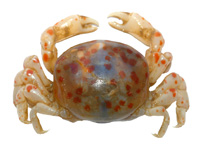Abstract
A new species of Cyrtodactylus (Geckoella) from the C. collegalensis complex is described based on a series of specimens from western and central India. Morphological and molecular data support the distinctiveness of the new form, which can be diagnosed from other Cyrtodactylus (including other Geckoella) species by its small body size (snout to vent length to 56 mm), the absence of precloacal and femoral pores, no enlarged preanal or femoral scales, and a dorsal scalation consisting wholly of small, granular scales. The new species is most closely related to C. collegalensis, C. speciosus and C. yakhuna, from which it differs by the presence of a patch of enlarged roughly hexagonal scales on the canthus rostralis and beneath the angle of jaw, its relatively long limbs and narrow body, and a dorsal colour pattern of 4–6 pairs of dark spots.
References
Agarwal, I. & Karanth, K.P. (2015) A phylogeny of the only ground-dwelling radiation of Cyrtodactylus (Squamata, Gekkonidae): diversification of Geckoella across peninsular India and Sri Lanka. Molecular Phylogenetics and Evolution, 82, 193–199.
http://dx.doi.org/10.1016/j.ympev.2014.09.016Bauer, A.M. (2003) Descriptions of seven new Cyrtodactylus (Squamata: Gekkonidae) with a key to the species of Myanmar (Burma). Proceedings of the California Academy of Sciences, 54, 463–498.
Beddome, R.H. (1870) Description of new reptiles from Madras presidency. Madras Monthly Journal of Medical Science, 2, 169–176, 2 pls.
Boulenger, J.A. (1885) Catalogue of the lizards in the British Museum (Natural History). I. Geckonidae, Eublepharidae, Uroplatidae, Pygopodidae, Agamidae. British Museum (Natural History), London, xii + 436 pp., 32 pls.
Deraniyagala, P.E.P. (1945) A new gymnodactylid gecko from Ceylon. Spolia Zeylanica, 24, 99–102.
Gupta, B.K. (1998) Note on the occurrence and growth of Geckoella collegalensis (Beddome, 1870). Hamadryad, 23, 77.
Hammer, Ø., Harper, D.A.T. & Ryan, P. (2001) PAST: Paleontological statistics software package for education and data analysis. Palaeontologia Electronica, 4, 9.
Mirza, Z.A., Pal, S. & Sanap, R.V. (2010) Notes on a ground gecko Geckoella cf. collegalensis Beddome, 1870 (Squamata, Sauria, Gekkonidae) from India. Russian Journal of Herpetology, 17, 8–14.
Prasanna, C. (1993) Leopard gecko (Cyrtodactylus collegalensis). Dactylus, 1, 33
Sanap, R., Mirza, Z.A. & Ullalkar, K. (2011) Notes on the reproduction and diet of Geckoella spp. in the north of the Western Ghats of Maharashtra, India. Sauria, 33, 47–50.
Sekar A.C. (1994) Range extension of the spotted forest gecko Cyrtodactylus collegalensis (Beddome, 1870). Journal of the Bombay Natural History Society, 91, 323–324.
Smith, M.A. (1935) The fauna of British India, including Ceylon and Burma. Reptilia and Amphibia. Vol. II. Sauria. Taylor and Francis, London, xiii + 440 pp., 1 pl., 2 folding maps.
Somaweera, R. & Somaweera, N. (2009) Lizards of Sri Lanka: a colour guide with field keys. Edition Chimaira, Frankfurt am Main, 304 pp.
Tamura, K., Peterson, D., Peterson, N., Stecher, G., Nei, M. & Kumar, S. (2011) MEGA5: molecular evolutionary genetics analysis using maximum likelihood, evolutionary distance, and maximum parsimony methods. Molecular Biology and Evolution, 28, 2731–2739.
http://dx.doi.org/10.1093/molbev/msr121Uetz, P. (2016) The Reptile Database. Available from: http://www.reptile-database.org (accessed 24 Apr. 2016)
Wood, P.L. Jr., Heinicke, M.P., Jackman, T.R. & Bauer, A.M. (2012) Phylogeny of bent-toed geckos (Cyrtodactylus) reveals a west to east pattern of diversification. Molecular Phylogenetics and Evolution, 65, 992–1003.
http://dx.doi.org/10.1016/j.ympev.2012.08.025

